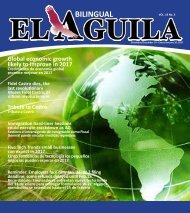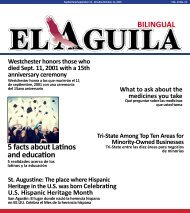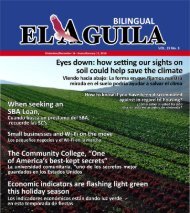El Aguila Magazine – January 11, 2017
Create successful ePaper yourself
Turn your PDF publications into a flip-book with our unique Google optimized e-Paper software.
<strong>El</strong> <strong>Aguila</strong> Enero/<strong>January</strong> <strong>11</strong> - Febrero/February 28 <strong>2017</strong><br />
Welcome to Honduras!<br />
TRAVEL AND LIVING<br />
<strong>11</strong><br />
Gorgeous Honduras has<br />
a bit of a public image<br />
problem thanks to its<br />
oft-reported crime stats, but<br />
any visitor will tell you that<br />
the situation on the ground<br />
couldn’t be more different<br />
from what’s heard in the media,<br />
and most travelers come<br />
back raving about a corner of<br />
Central America that is frequently<br />
overlooked. These,<br />
then, are ten reasons why you<br />
shouldn’t simply rush through<br />
this fantastic destination.<br />
Sure, every overlander has<br />
spent time in the jungles of Costa<br />
Rica or seen the Maya ruins<br />
of Guatemala, but how many<br />
have been to Honduras? This<br />
is Central America’s least visited<br />
country, despite being its<br />
second largest, and you won’t<br />
find yourself the target of touts,<br />
ripped off or otherwise hustled.<br />
Indeed, in most places you’ll<br />
be a pleasant curiosity for the<br />
friendly locals, and even when<br />
you get to a tourist hub such as<br />
the Bay Islands, things remain<br />
low key and laid back.<br />
Since traveler numbers are low,<br />
competition between agencies<br />
and hotels is fierce and<br />
this works to your advantage.<br />
Moreover, Honduras is not an<br />
expensive country in the first<br />
place, so you can easily get by<br />
on US$25 per day for food and<br />
lodging. Buses are cheap and<br />
The white sands and turquoise waters of Tabyana Beach , in Roatan<br />
generally comfortable, and you<br />
can get particularly good prices<br />
for activities and tours, meaning<br />
that many people planning simply<br />
to pass through Honduras<br />
end up staying for weeks.<br />
For decades the Bay Islands, and<br />
Utila in particular, have been the<br />
cheapest place to learn to dive<br />
in the Americas. While recent<br />
taxes levied on the activity now<br />
make this status a little less clear<br />
cut, Utila remains a great place<br />
to qualify, with its dozen diving<br />
schools providing constant<br />
healthy competition. The diving<br />
is excellent to boot: blooming<br />
coral reefs, sea turtles and even<br />
whale sharks are all commonly<br />
spotted, and non-divers can have<br />
fun with outstanding snorkeling<br />
opportunities.<br />
The only thing divers seem to<br />
like more than diving is partying,<br />
and nowhere is this more evident<br />
than on the backpacker island of<br />
Utila. At the diving schools, the<br />
night’s activities often continue<br />
until the dawn light, with parties<br />
on beaches, nearby cays, dive<br />
bars and even in a tree house. Be<br />
warned: you may well miss your<br />
8am dive.<br />
Credit: Konrad Wothe<br />
The country’s most famous historical<br />
site is undoubtedly the<br />
extraordinary Maya ruins at Copán.<br />
This extremely well-preserved<br />
ancient city includes some<br />
of the best Maya stelae in existence,<br />
and its greatest king was<br />
called 13 Rabbit, which is kind<br />
of cool. The Copán siteis located<br />
in gorgeously thick forest that is<br />
home to the spectacular scarlet<br />
macaw (not to mention clouds<br />
of mosquitoes <strong>–</strong> bring plenty of<br />
repellent), and it’s a short walk<br />
from the charmingly preserved<br />
town of Copán Ruinas, a laid<br />
back and friendly oasis full of<br />
cobble stone streets and colonial-era<br />
houses.<br />
With over a dozen national<br />
parks, several impressive mountain<br />
ranges, thick rainforest and<br />
the biodiverse Lago de Yojoa<br />
to choose from, ecotourism opportunities<br />
come thick and fast<br />
in Honduras. You can volunteer to<br />
work with endangered iguanas in<br />
Utila, do an impressive three waterfall<br />
hike through the foothills of the<br />
Parque Nacional Montaña de Santa<br />
Bárbara, see hundreds of different<br />
trees and plants at the Lancetilla<br />
Jardín Botánico near Tela and make<br />
your way by boat through the jungle<br />
wildernesses of La Mosquitia,.<br />
You have to make a bit of effort to<br />
find Honduras’ best beaches, as the<br />
ones near the bigger towns on the<br />
Caribbean coast tend to be rather<br />
dirty, but they’re worth the hassle.<br />
You’ll find idyllic white coral sands<br />
on the cays around Utila, some truly<br />
dazzling golden stretches of playa<br />
on Roatán, a number of totally<br />
empty beaches backed by soaring<br />
mountains around Trujillo and even<br />
dark volcanic sands on the Pacific<br />
island of <strong>El</strong> Tigre.<br />
You’ve got some real choice in<br />
Honduras when it comes to extreme<br />
sports. White water rafting down<br />
the sublime Río Cangrejal should<br />
not be missed, and the rapids are<br />
some of the most exciting and<br />
challenging you’ll find in Central<br />
Birds fly over Lago de Yojoa in western Honduras<br />
America. You can also try free-diving<br />
in the Bay Islands, where this<br />
little-known discipline has taken<br />
off in recent years. There’s also two<br />
excellent zip-lining opportunities<br />
available, one in the mountainous<br />
landscapes of La Campa, a small<br />
town near Gracias, and another<br />
over the jungle canopy in the Garifuna<br />
village of Sambo Creeknear<br />
La Ceiba.<br />
With its incredible biodiversity,<br />
Honduras is an extremely rewarding<br />
destination for birdwatchers,<br />
and among the more than 700 recorded<br />
species you’ll find the magnificent<br />
quetzal (best seen on a<br />
climb of Montaña Santa Bárbara)<br />
and the scarlet macaw (easily seen<br />
at Copán, the site of their recent<br />
reintroduction to the wild). Other<br />
creatures you can usually spot with<br />
some ease include magnificent<br />
whale sharks and docile sea turtles<br />
that swim off Utila, monkeys in the<br />
various jungle reserves along the<br />
Caribbean coast and even manatees,<br />
iguanas and tapir elsewhere in<br />
this always surprising destination.<br />
Source: Lonely Planet<br />
Credit: Wilfredo Escobar
















